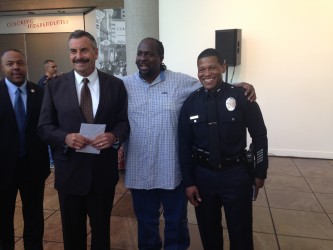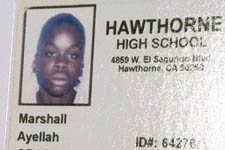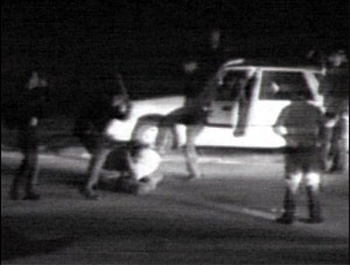
LAPD Chief Charlie Beck spoke with the South LA residents at his forum in Exposition Park. | Photo by Etienne Smith
The Los Angeles Police Department is promising changes in the way it relates to the community, it announced just weeks after saying it would add more officers to South Los Angeles streets.
About 40 community members were present to hear Los Angeles Police Department Chief Charlie Beck discuss the relationship between the city’s police and the community. The discussion, in the format of a breakfast, was held at the California African American Museum this past Friday.
“Everybody has a responsibility to make this a safer place to live,” Beck said, “a place our young people and all of us can go to have a sense of community.”
These types of forums began in 1999 to “[involve] minority communities in time-sensitive issues,” according to the forum’s website. On that Friday, the forum was discussion-based and then audience members asked questions to LAPD’s top man. The LAPD has evolved in its relationship to the South LA community. More efforts are being made to not just police the community, but work as partners with it.










 Jasmyne Cannick
Jasmyne Cannick The Los Angeles Police Department announced their new focus on eight new women connected to the Grim Sleeper. Six were missing persons, one was an unsolved homicide case, and the eighth woman is unidentified.
The Los Angeles Police Department announced their new focus on eight new women connected to the Grim Sleeper. Six were missing persons, one was an unsolved homicide case, and the eighth woman is unidentified. The Wilborns were well-known in South Los Angeles, as Sulema was a long-time activist who worked for celebrity lawyer Thomas Mesereau’s legal clinic and 49-year-old Jerriell worked with The Wrecking Crew Church’s community outreach program.
The Wilborns were well-known in South Los Angeles, as Sulema was a long-time activist who worked for celebrity lawyer Thomas Mesereau’s legal clinic and 49-year-old Jerriell worked with The Wrecking Crew Church’s community outreach program. You can’t hear much on the video tape. But the pictures of a man on the ground beaten by a crowd of police officers startled the nation. His name was Rodney King – a name that would become synonymous with Los Angeles Police Department brutality.
You can’t hear much on the video tape. But the pictures of a man on the ground beaten by a crowd of police officers startled the nation. His name was Rodney King – a name that would become synonymous with Los Angeles Police Department brutality.





